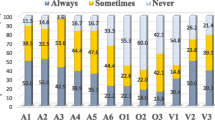Abstract
This study describes HIV and syphilis bio-behavioral survey conducted among 200 men who have sex with men (MSM) recruited via respondent-driven sampling (RDS) between January 4 and February 1, 2012 in Ulaanbaatar, Mongolia. Participants were administered a structured questionnaire and data were analyzed with RDS-network program in STATA. Of 196 participants who agreed to be tested for HIV and syphilis, 21 (10.7 %; weighted 7.5; 95 % CI: 4.9, 11.4) and 8 (4.1 %; weighted 3.4; 95 % CI: 1.7, 6.7) were positive for HIV and syphilis, respectively. Exposure to HIV prevention programs in the last 12 months was reported by 51.8 % (weighted 33.6; 95 % CI: 27.6, 40.1) of participants. This study found high HIV prevalence and limited uptake of HIV prevention services among MSM in Mongolia. Given the concentrated HIV epidemic among MSM in Mongolia, HIV prevention, treatment and care services should focus on MSM as the population group most affected by HIV.
Resumen
Este estudio reporta una encuesta de VIH y sífilis conducido en 200 hombres que tienen sexo con hombres (HSH) los cuales fueron enrolados a través un muestreo guiado por los participantes entre enero 4 y febrero 1 del 2012 en Ulaanbaatar, Mongolia. Los participantes recibieron un cuestionario estructurado y la información se analizo con el programa Stata. De los 196 participantes quienes estuvieron de acuerdo en ser testeados para el VIH y sífilis, 21 (10.7 %; tasa ajustada 7.5; 95 % IC: 4.9, 11.4) and 8 (4.1 %; tasa ajustada 3.4; 95 % IC: 1.7, 6.7) fueron positivos para VIH y sífilis, respectivamente. Exposición a los programas de prevención del VIH en los últimos 12 meses fue reportado por 51.8 % (tasa ajustada 33.6; 95 % IC: 27.6, 40.1) de los participantes. Este estudio ha documentado que HSH tienen una alta prevalencia de VIH y limitado servicios de prevención para VIH. Dada la concentrada epidemia del VIH en HSH en Mongolia, la prevención y tratamiento del VIH así como servicios de asistenciales deberían focalizarse en HSH debido a que este grupo es la más afectada por la epidemia del VIH.

Similar content being viewed by others
References
National Statistical Office of Mongolia, Population and Housing Census Bureau. Population and Housing Census–2010. Available at: http://www.toollogo2010.mn/. Accessed May 26 2013.
Ministry of Health. Report of the midterm external review of the implementation of the national strategic plan on HIV/AIDS and STIs for 2010–2015, Mongolia. Ministry of Health, Ulaanbaatar, Mongolia. 2013.
Roberts AB, Oyun C, Batnasan E, Laing L. Exploring the social and cultural context of sexual health for young people in Mongolia: implications for health promotion. Soc Sci Med. 2005;60(7):1487–98.
Beyrer C, Trapence G, Motimedi F, et al. Bisexual concurrency, bisexual partnerships, and HIV among Southern African men who have sex with men. Sex Transm Infect. 2010;86(4):323–7.
Cáceres CF, Pecheny M, Frasca T, Rios RR. Review of legal frameworks and the situation of human rights related to sexual diversity in low and middle income countries. UNAIDS, 2009.
Godwin J. Legal environments, human rights and HIV responses among men who have sex with men and transgender people in Asia and the Pacific: an agenda for action. Bangkok: UNDP; 2010.
Ministry of Health. Second generation HIV/STI surveillance report. Ministry of Health. Ulaanbaatar, Mongolia. 2009.
Yasin F, Delegchoimbol A, Jamiyanjamts N, et al. A Cross-sectional evaluation of correlates of HIV testing practices among men who have sex with men (MSM) in Mongolia. AIDS Behav. 2013;17(4):1378–85.
Heckathorn D. Respondent-driven sampling: a new approach to the study of hidden populations. Soc Probl. 1997;44(2):174–99.
Dean AG, Sullivan KM, Soe MM. OpenEpi: open source epidemiologic statistics for public health, Version 2.3.1. http://www.OpenEpi.com 2011. Accessed Date 23 06 2011.
Salganik MJ. Variance estimation, design effects, and sample size calculations for respondent-driven sampling. J Urban Health. 2006;83(6 Suppl):i98–112.
Rao JN, Scott AJ. On Chi squared tests for multiway contingency tables with cell proportions estimated from survey data. Ann Stat. 1984;12:46–60.
Schonlau M, Liebau E. Respondent driven sampling. The STATA Journal. 2012;12:72–93.
Borgatti S. Netdraw network visualization. Harvard: Analytic Technologies; 2002.
Davaalkham J, Unenchimeg P, Baigalmaa C, et al. Identification of a current hot spot of HIV type 1 transmission in Mongolia by molecular epidemiological analsyis. AIDS Res Hum Retroviruses. 2011; 27(10): 1073–1080.
Sweat M, Gregorich S, Sangiwa G, et al. Cost-effectiveness of voluntary HIV-1 counselling and testing in reducing sexual transmission of HIV-1 in Kenya and Tanzania. Lancet. 2000;356(113):121.
Cohen MS, Chen YQ, McCauley M, et al. Prevention of HIV-1 infection with ealry antiretroviral therapy. N Engl J Med. 2011;365:493–505.
National Committee on HIV/AIDS. National AIDS spending assessment (2010-2011). Ulaanbaatar: Ministry of Health; 2012.
National Committee on HIV/AIDS. Country progress report: Mongolia. Global AIDS progress report. Ulaanbaatar: Ministry of Health; 2012.
HIV and MSM. Mongolia country snapshot, December 2012. Available at: http://www.aidsdatahub.org. Accessed December 19, 2013.
Author information
Authors and Affiliations
Corresponding author
Additional information
Iliza Azyei and Bulbul Aumakhan contributed equally to the manuscript.
Rights and permissions
About this article
Cite this article
Azyei, I., Aumakhan, B., Jantsansengee, B. et al. Evolving Understanding of the Epidemiology of HIV and Prevention Needs among Men Who Have Sex with Men in Ulaanbaatar, Mongolia. AIDS Behav 18, 2009–2019 (2014). https://doi.org/10.1007/s10461-014-0780-5
Published:
Issue Date:
DOI: https://doi.org/10.1007/s10461-014-0780-5




